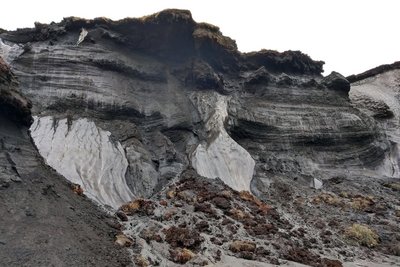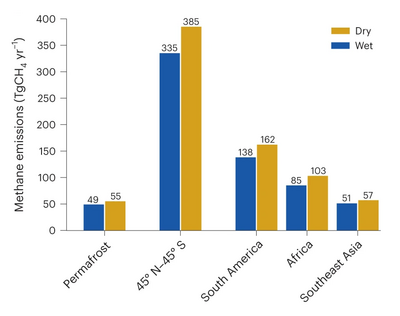The precarious future of permafrost

In 1827, the Russian merchant Fyodor Shergin tried to dig a well in the backyard of his house in Yakutsk, Siberia. But instead of liquid water, all he found was frozen ground. Shergin gave up at a depth of 15 meters. A while later, scientists became interested and persuaded Shergin to keep digging. After ten years, the mine had reached its present depth of 116 meters, and Yakutsk became known as the cradle of permafrost science.
Permanently frozen ground, or permafrost, is a relic of the last ice ages. The temperature of these soils is below freezing point for at least two consecutive years – regardless of whether they consist of peat, coarse or fine-grained rock, or whether or not they contain ice. Most permafrost is found in the northern hemisphere, where it covers around a quarter of the land surface, mainly north of the Arctic Circle. In Scandinavia, it reaches a depth of 20 meters, up to several hundred meters in Alaska and up to 1500 meters in Siberia – explaining all too well why Shergin had such trouble finding liquid water in his yard.

DOI: 10.1029/2021JF006123
On the surface of the permafrost lies the so-called active layer, which thaws in summer and allows plants to grow: grasslands, forests, or wetlands with ponds and lakes. In some areas, the landscape resembles a mosaic, as if countless polygons had been painstakingly laid together. This structure is created from the depths during the cold Arctic winter, when the frozen ground contracts and cracks. These cracks fill with meltwater during springtime, which then freezes to form ice wedges, creating the fascinating geometric pattern on the surface.
From the ice ages to global warming
These landscapes are changing: Measurements show that in recent decades, the Arctic has warmed significantly faster than the Earth on average. As a result, the permafrost is beginning to thaw down to deeper layers. The consequences include subsidence and erosion. Many lakes are disappearing because the water can now drain, while new ponds form in the depressions left behind by the sinking ground, and others merge to form lakes because the limiting ice is missing. The landscape criss-crossed by bodies of water and sagging permafrost is known among experts as Thermokarst – the first part of the word describes the cause, the second the jagged appearance of these structures.

The thawing of the permafrost not only changes the face of the Arctic, it also has an impact on Earth's climate. This is because permafrost stores huge amounts of carbon – the soils in the permafrost region hold around twice as much as the atmosphere. It is fixed in the form of dead plants, whose decomposition is prevented by the low temperatures and low oxygen. When the permafrost thaws, microorganisms begin to break down the material. This produces greenhouse gases: carbon dioxide (CO2) or methane, which has about 28 times the warming effect of CO2 on a time horizon of 100 years. These gases also escape from the ponds and lakes, where a lot of carbon is decomposed as well.
Climate researchers are therefore trying to understand how the Arctic will react to rising temperatures: Will it release its large carbon deposits into the atmosphere, and if so, when and in what form? At the Max Planck Institute for Meteorology (MPI-M), researchers are investigating the processes in the Arctic. Victor Brovkin, who was born and raised in Yakutsk, not far from Shergin’s mine, leads the “Climate-Biosphere interactions” working group at MPI-M and is co-chair of the “Carbon Dynamics in the Arctic” working group of the Cluster of Excellence Climate, Climatic Change and Society (CLICCS) at the University of Hamburg.
Drier or wetter: both have consequences
Until recently, researchers have been concerned with the question of whether the carbon stored in the soil will escape in the form of CO2 or in the form of methane, which has an even stronger warming potential. The answer depends, among other things, on whether the Arctic becomes wetter or drier in the future. This is because in dry soils, microorganisms decompose plant material with the help of oxygen, producing CO2 in the process. In waterlogged soils, on the other hand, oxygen is rare or absent, so that methane is produced when the organic material decomposes.

However, it is not yet clear whether the Arctic is becoming drier or wetter. Simulations with Earth system models (ESMs) show increasing precipitation for this region in the future – which may lead to wetter conditions at the surface and help maintain the high density of surface water bodies and areas with waterlogged soils. Nevertheless, there are also arguments in favor of a future drying of permafrost landscapes. According to this, the thawing of the permafrost would lower the water table and allow water to drain away more easily, causing the soil to dry out in the long term.
MPI-M researcher Philipp de Vrese and his colleagues have used the coupled climate model MPI-ESM to show what this could mean for methane emissions in the Arctic. According to their findings, in a wetter Arctic with an extensive wetland cover, more methane would actually be emitted in some places – but not everywhere. This is because the evaporation of water from the moist soils cools the land surface, which inhibits plant productivity and methane production. Conversely, less soil moisture results in fewer clouds. As a consequence, more solar radiation reaches the land surface, amplifying local warming. Plant growth is stimulated and more substrate becomes available for the microorganisms, increasing methane production. CLICCS scientists recently showed that this is also the reason for rising methane emissions from ponds. Therefore, the simple logic that methane fluxes increase in a wet Arctic and decrease in a dry Arctic is not necessarily correct.
Understanding the global effects

What all this means for the global climate can only be understood if, in addition to the carbon cycle, direct interactions with the atmosphere are taken into account: If cloud cover over the Arctic were to actually decrease and if the high latitudes were to heat up, the temperature gradient between the tropics and the Arctic would decrease. According to the simulations, this could affect precipitation patterns near the equator, hence methane emissions from tropical wetlands. These are already the largest natural source of methane today and could release even more into the atmosphere in the future. "It is truly astonishing that a spatially limited process would have such far-reaching consequences," says Philipp de Vrese.
The scientists owe it to their models that these consequences have been uncovered. "Earth system modeling provides answers to global questions. It allows us to compare different scenarios and make projections for the future," says group leader Victor Brovkin.
Modeling also revealed the future evolution of coastal permafrost erosion, as work done in the MPI-M working group “Ocean Biogeochemistry” shows: On the Arctic coast, waves and increasing temperatures are removing material from the thawing permafrost – currently around half a meter of coast retraction per year, which is likely to double or triple by the end of the century according to calculations. This not only threatens coastal communities, but also has a further impact on the ocean carbon cycle: The carbon contained in the eroded material ends up in the ocean, where it is decomposed. As a result, the CO2 content in the ocean surface increases, which slows down the oceanic uptake of CO2 from the atmosphere. "The Arctic Ocean absorbs relatively large amounts of CO2 compared to its size", says CLICCS climate researcher David Nielsen. "But Earth system models haven't yet been able to simulate this carbon sink quite right." If the impact of coastal permafrost erosion is considered, the inner Arctic Ocean could absorb between nine and 19 percent less CO2. The increasing CO2 content in seawater due to erosion also makes the ocean more acidic, threatening the health of marine ecosystems.
Challenges for modeling
Whether, when and in what form the Arctic will release its large carbon deposits into the atmosphere, and what effects this will have, are therefore complex questions that can only be understood with Earth system models. But: "There is currently a gap between the spatial scale on which the relevant processes take place and the resolution of the Earth system models," says Victor Brovkin. This is because in models the grid placed over the Earth's surface, hence, the simulated variables, such as temperature, precipitation or carbon fluxes, is on a kilometer to 100-km scale. However, many relevant landscape characteristics are heterogeneous on much finer, sometimes meter scales.

In order to account for the rich diversity of Arctic environments, the MPI-M has joined forces with the Max Planck Institute for Biogeochemistry in Jena and the Austrian company b.geos in the “Q-Arctic” project funded by the European Research Council. The team collects observational data on sites and by satellites in order to identify relevant landscape properties. At the same time, they are working on ways to make use of this information in the ICON Earth system model: Characteristic landscape features can be defined within each grid element, based on topography, soil properties and vegetation distribution. This, for example, allows the model to determine what percentage of a grid cell is covered by wetlands under the simulated climate. First results obtained with this apporach are promising: the representation of small-scale surface water bodies and waterlogged soils in the grid cell already improves the modeling results.
But just like Shergin once did, scientists are still seeking to dig deeper. The approach of treating sub-grid scale heterogeneity is currently limited to the physical processes at and below the land surface. The next step is to represent the biogeochemical and biophysical processes at the same level of detail. Up until now, a lot of the research on the permafrost region has been centered on the carbon emissions from thawing soils. With their research, Brovkin’s groups aim to broaden this focus and thereby deepen their understanding of how biogeochemical and biogeophysical feedbacks in permafrost landscapes work together to influence Earth’s climate.
Further information
Working group “Climate-Biosphere Interaction” at MPI-M
Working group “Ocean Biogeochemistry” at MPI-M
Original publications
de Vrese, P., Stacke, T., Gayler, V. & Brovkin, V.: Permafrost cloud feedback may amplify climate change. Geophysical Research Letters, 51 (2024). doi:10.1029/2024GL109034
de Vrese, P., Beckebanze, L., Galera, L., Holl, D., Kleinen, T., Kutzbach, L., Rehder, Z. & Brovkin, V.: Sensitivity of Arctic CH4 emissions to landscape wetness diminished by atmospheric feedbacks. Nature Climate Change 13, 832–839 (2023). doi:10.1038/s41558-023-01715-3
Nielsen, D., Chegini, F., März, J., Brune, S., Mathis, M., Dobrynin, M., Baehr, J., Brovkin, V. & Ilyina, T.: Reduced Arctic Ocean CO2 uptake due to coastal permafrost erosion. Nature Climate Change 14, 968–975 (2024). doi:10.1038/s41558-024-02074-3
Nielsen, D., Pieper, P., Barkhordarian, A., Overduin, P., Ilyina, T., Brovkin, V., Baehr, J. & Dobrynin, M.: Increase in Arctic coastal erosion and its sensitivity to warming in the twenty-first century. Nature Climate Change 12, 263–270 (2022). doi:10.1038/s41558-022-01281-0
Rehder, Z., Kleinen, T., Kutzbach, L., Stepanenko, V., Langer, M. & Brovkin, V.: Simulated methane emissions from Arctic ponds are highly sensitive to warming. Biogeosciences, 20, 2837-2855 (2023). doi:10.5194/bg-20-2837-2023
Schickhoff, M., de Vrese, P., Bartsch, A., Widhalm, B. & Brovkin, V.: Effects of land surface model resolution on fluxes and soil state in the Arctic. ERL, 19: 104032 (2024). doi:10.1088/1748-9326/ad6019
Contact
Prof. Victor Brovkin
Max Planck Institute for Meteorology
Cluster of Excellence Climate, Climatic Change, and Society (CLICCS), University of Hamburg
victor.brovkin@mpimet.mpg.de
Dr. Philipp de Vrese
Max Planck Institute for Meteorology
philipp.de-vrese@mpimet.mpg.de
Dr. David M. Nielsen
Max Planck Institute for Meteorology
Cluster of Excellence Climate, Climatic Change, and Society (CLICCS), University of Hamburg
david.nielsen@mpimet.mpg.de
